Dirk Nowitzki can’t recall exactly when it hit him, that his greatest moments of glory—of 50-win seasons and thrilling playoff runs and championship chases—were over. Only that it did hit him. Hard.
It might have been late in 2011, as he watched key teammates depart, just months after the Mavericks won the title. Or maybe it was the following spring, when the Mavs got swept in the first round. Or the next year, when they missed the playoffs entirely.
But Nowitzki knew, as an NBA star in his mid-30s, that time was running out.
“You’ve done everything that you wanted to do on an individual basis—All-Star games and accolades, All-NBA teams—but all you want to really do down the stretch is win,” Nowitzki says. “Win as much as you can, compete at the highest level. And so those were tough times.”
Tougher still because Nowitzki was still elite. He made the top 10 in scoring in 2011–12, hit 41% of his threes in ’12–13, set a career high in efficiency in ’13–14. He was still making All-Star teams. But the Mavs? The Mavs were cooked—doomed by defections, an aging roster and some bad bets.
So, yes, Nowitzki feels a familiar pang now when he flips on the TV and sees LeBron James throwing passes to guys who can’t shoot, forcing shots he shouldn’t need to take and losing games at a rate he can’t fathom. “You can definitely see there’s some frustration there,” Nowitzki says.
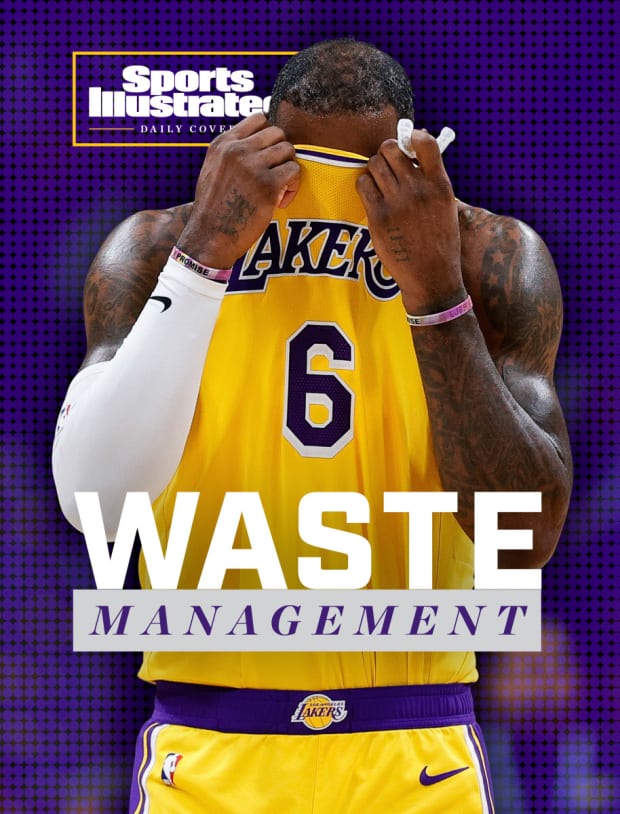
Isaiah J. Downing/USA TODAY Sports
Few players can relate to what James is now enduring—as a living legend, still thriving in his twilight, yet bound to a ramshackle roster. In fact, on the most literal level, no one can truly relate. Because the bleak situation James now faces in Los Angeles is virtually unprecedented for a player of his age and caliber.
The Lakers—now 12th in the West, three games under .500 with a third of the season gone—are careening toward catastrophe, with a roster that’s too thin to support their aging legend. And now costar Anthony Davis is out again, with a foot injury that could cost him several weeks. The Lakers (13–16) seem likely to miss the playoffs next spring, just as they missed the playoffs last spring, despite another All-NBA showing by James.
Though he’s been limited by injuries and less efficient than usual, James is still stuffing the box score, averaging 27.0 points, 8.5 rebounds and 6.5 assists in 22 games. Only one other player is averaging at least 25/8/6: Luka Dončić, who is 14 years younger than James. Should he sustain his pace, James—who turns 38 next week—would be the oldest to average those marks in a full season, breaking the records set by LeBron James at age 37, LeBron James at age 34, LeBron James at age 33 and LeBron James at age 32.
But there’s no telling how much longer James can do this, or whether the Lakers can fix this, which leads us to one profoundly sobering conclusion: that the Lakers are, by every imaginable definition, tragically squandering the last, best years of one of the greatest players in NBA history.
“Last season was a wasted season,” says Richard Jefferson, James’s friend and former teammate.
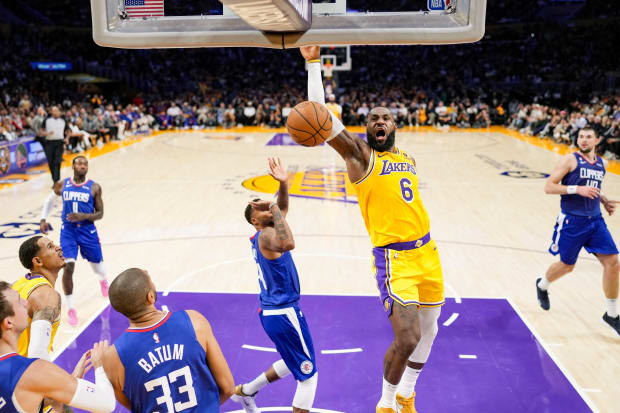
Kirby Lee/USA TODAY Sports
And this season seems likely to end similarly: with an April exit, a whimper instead of a bang, another wasted year.
It’s rare, even for all-time NBA greats, to produce at an All-Star level this late in a career. It’s even more rare to have those efforts go for naught. Consider:
- Last season, James produced a value over replacement player (VORP) of 5.1—the third-best mark for a player age 37 or older, per Stathead. Only Jazz stars Karl Malone (in 2000–01) and John Stockton (in 1999–2000) scored higher, and both made the playoffs. (For purposes of this exercise, we included all seasons since 1979–80, and restricted it to players who made the All-Star team.)
- Lower the age threshold to 35-plus, with a minimum VORP of 4.0, and the picture grows more damning for the Lakers. It’s happened 16 times—with multiple appearances by Malone and Kareem Abdul-Jabbar, plus individual seasons by Tim Duncan, Steve Nash, Chris Paul and Nowitzki, among others—and all made the playoffs except James (in 2022) and Pau Gasol (with the Bulls in ’16).
Players generally start to decline around age 32, although some all-time greats have sustained a VORP of 3.5 or higher (approximating All-Star–level production) into their late 30s. That’s happened 92 times over the last 43 seasons, per Stathead. Among those players:
- Eighty-five made the playoffs.
- Fifty-six made at least the second round.
- Thirty-five made at least the conference finals.
- Twenty made the Finals.
- Eleven won the championship.
- Only seven missed the playoffs, a group that includes James twice (2019, ’22), Stephen Curry (’21), Gasol (’16), Gary Payton (with Seattle in ’01), Mitch Richmond (with Sacramento in 1998) and Artis Gilmore (with Chicago in ’82).
Of that group, Curry is the only player even close to James’s stratosphere, and that 2020–21 Warriors season was a momentary aberration, with Klay Thompson missing the entire season, and both Curry and Draymond Green out for long stretches. The Warriors, of course, bounced back with a championship the next year.
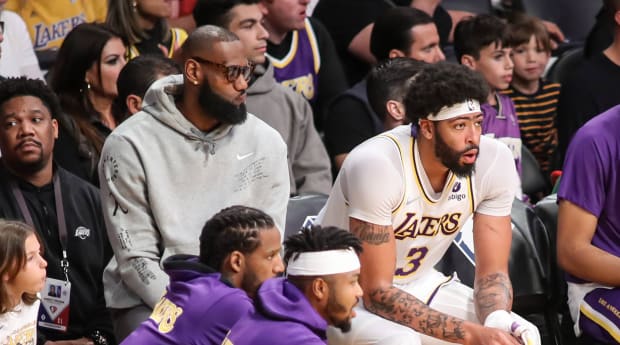
Jevone Moore/Icon Sportswire/IMAGO
But James has missed the playoffs twice in his four L.A. seasons and is on track to miss them again. And, unlike some of the others referenced above, James isn’t just among the all-time greats, but one of the greatest, period—a certified GOAT candidate—which makes every bad trade, every poor signing and every blown season that much more offensive, a sacrilege, an affront to the Basketball Gods.
If we could create a formula to measure the flagrant misuse of an aging legend—call it the Squandered Superstar Index—the Lakers might be guilty of the greatest SSIN in basketball history.
Kareem never suffered this indignity while he was still performing at an elite level. Nor did Wilt, nor Magic, nor Kobe, nor Shaq. Nor did Bill Russell, nor Larry Bird, nor Duncan, nor David Robinson, nor Hakeem Olajuwon. (Nor did Michael Jordan, who was pretty ordinary in his two miserable seasons with Washington.) If they were still great, their teams were still relevant. If their teams were toast, well, it was usually because the stars were, too.
Which means LeBron’s current plight is indeed unique, and uniquely wasteful.
“You need to insulate great players even more as they get older,” says Jefferson, now an analyst for the YES Network and ESPN.
He pointed to Duncan’s final years in San Antonio, where Tony Parker, Manu Ginóbili and Kawhi Leonard helped fuel two more Finals runs, including a championship in 2014, when Duncan was 38.
“Look at the talent that he had around him,” Jefferson says. “They insulated Tim Duncan the proper way. I think at times with star players, that’s the burden that they’re expected to carry—like, ‘Well, we have LeBron James, we should be fine.’ LeBron James will be the first person to tell you that his success is all predicated on the quality of teammates that he has around him, and then his ability to mold that into a great team and into a force. But he’s always had talent around him.”
It should be noted here that James missed six games early this season because of a groin injury, adding to his team’s struggles. But the Lakers were a dismal 2–9 before he went down and, well, no one around the league was particularly surprised, because team officials did nothing to upgrade the roster after going 33–49 last season. They still lack three-point shooting. They’re still thin at center. They still need perimeter defenders. And, of course, they still have Russell Westbrook, who is now thriving as the sixth man but remains a poor fit on a LeBron-centric team.
These critiques aren’t just coming from scouts and pundits.
James himself called out the shooting deficiencies on opening night, after the Lakers went 10-for-40 on threes in a loss to the Warriors. “Being completely honest, we’re not a team that’s constructed of great shooting,” he said. “That’s just the truth of the matter.” Indeed, the Lakers rank dead last in three-pointers made (9.8 per game) and second-to-last in three-point accuracy (.325).
At the 10-game mark, with the Lakers sitting at 2–8, Davis noted that his best play—and a championship—came in 2020, when Dwight Howard and JaVale McGee rotated at center, allowing Davis to roam freely on defense. “We were flying around; we were really good defensively,” he said. “It’s tough for me to do that when I’m guarding the 5.” The Lakers let both McGee and Howard leave and have struggled to fill the hole ever since.
On the same night Davis made his remarks, coach Darvin Ham went on an unusual (and unsolicited) tangent about the Lakers’ salary-cap and luxury-tax limitations, citing how much of the payroll was tied up in James, Davis and Westbrook. Intentional or not, it was yet another indictment of the Lakers’ roster construction.
The Lakers weren’t so top-heavy when they won the championship two years ago. That roster featured just two max players (James and Davis), flanked by a well-calibrated supporting cast of shooters and defenders, from Kyle Kuzma and Kentavious Caldwell-Pope to Danny Green, Markieff Morris, Alex Caruso and Rajon Rondo, along with Howard and McGee. All of them are gone.
Of the 15 players involved in that 2020 postseason run, only James and Davis remain.
“We know what happened,” Green said on a recent episode of the Crossover podcast, addressing the Lakers’ rapid decline. “There’s a lot of good pieces that were good fits for them that they let go or traded away. It doesn’t take a rocket scientist to figure out what you need around LeBron and AD.”
A good chunk of that support was sacrificed in the ill-conceived trade for Westbrook, which directly cost the Lakers the services of Kuzma, Caldwell-Pope and Montrezl Harrell, and indirectly cost them Caruso, who left in free agency when the Lakers balked at his asking price. (Those decisions were ultimately made by general manager Rob Pelinka, but it bears noting that James himself reportedly pushed for the Westbrook deal, which arguably makes him at least partially responsible for the ill state of the roster today.)
Three perspectives on how badly the supporting cast has eroded:
- Nine players in the Lakers’ rotation last season were out of the NBA as of opening night this season. (One, Stanley Johnson, signed with the Spurs last week.)
- The Lakers’ core this season features a half dozen players who were nominal or fringe rotation players last season.
- Outside of James and Davis, the Lakers don’t employ a single player who would rank in the top 100, based on an aggregate of advanced stats, per Andy Bailey’s Substack. According to Bailey’s list, the highest-ranking Laker not named James or Davis is Austin Reaves, at 144th. Westbrook is 172nd.
Even peak-years LeBron—who dragged a nondescript Cavaliers roster to the Finals in 2007, and repeated the feat in ’18—would be powerless with this Lakers team.
This version of LeBron, now in Year 20, has certainly lost some potency, a fact that shows up in his diminishing free throw attempts and declining shooting percentages, as well as the nagging injuries.
His advanced stats have suffered because of all the missed games. But the raw box-score numbers suggest he’s still a top-10 player, as he was last season. And though his scoring efficiency is down some, that can be explained in part by forcing tougher shots, by the lack of shooting and spacing around him, and, perhaps, by the realization that this team is fatally flawed.
“For this guy, who we would consider one of the great basketball minds of all time, to be almost in a space of teaching some players at this age in his career, where he should be hopefully competing for playoffs and championships, that’s the part where you're like, ‘Man, I feel for him,’” Jefferson says.
When James signed a two-year extension in August—committing him through the 2024–25 season—he did so with assurances the Lakers would do whatever was necessary to improve the roster, even if it meant trading future first-round picks. But team officials have been extremely reluctant to part with those picks —a position that’s irritated James and his camp, as Chris Haynes of Turner Sports reported last month.
The Lakers had found their stride recently, winning 11 of 17 games, including impressive victories over the Bucks and Nuggets. But that resurgence was mostly due to a soft schedule, with five wins coming against the Spurs and Pistons, two of the league’s worst teams. Regardless, few people around the league believe the Lakers, as constructed, are capable of winning a playoff series.
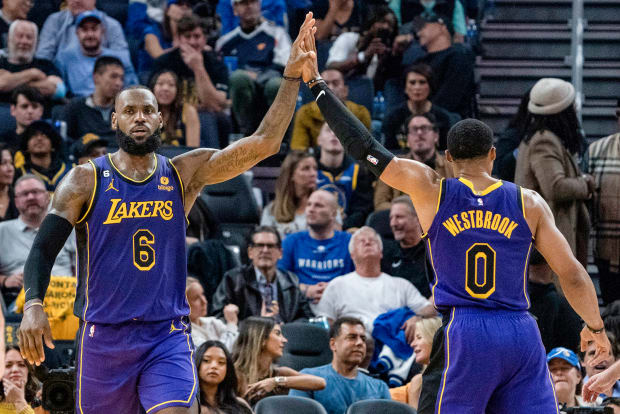
Kyle Terada/USA TODAY Sports
“They are still a very flawed roster,” says ESPN analyst Jeff Van Gundy, “but Davis, James and Westbrook have played well—and most importantly, well together—since James returned from injury. However, without a major upgrade to the roster, it’s difficult to see how they can be more than a play-in team.”
A proposed deal sending Westbrook and two unprotected picks (in 2027 and ’29) to Indiana for Myles Turner and Buddy Hield generated the most buzz in the offseason and perhaps remains the most concrete option, assuming the resurgent Pacers are still interested. It wouldn’t necessarily make the Lakers contenders; no single move would. But it would solve multiple problems—improving their starting lineup, their shooting and their interior defense—and put them in the playoff hunt.
A deal along those lines would at least make the Lakers respectable, and isn’t that the minimum obligation a franchise has to an all-time great? If championship or bust is the standard, as team officials have hinted, the Lakers could be holding on to those picks, and missing the playoffs, right until the moment James retires … or leaves in free agency … or perhaps demands a trade.
That last option sounds extreme at the moment (and cannot happen until next summer, because of his newly signed extension), but few around the league would be surprised, given James’s team-hopping habits over the last decade.
Jefferson advocates for the win-now approach, noting: “When LeBron James moves on, you’re gonna have to rebuild, anyway.”
Yet sources around the league believe that Lakers officials, led by Pelinka, are holding out hope for a revival, and holding on to the draft picks in the hope they can parlay them into a bigger prize, such as the Wizards’ Bradley Beal.

It’s reached the point where celebrity Lakers fans are openly begging the team to act. “Dear Rob Pelinka, do something now,” Flea, the bassist for the Red Hot Chili Peppers, pleaded in a tweet earlier this season. “Either blow it all up and rebuild, or mortgage the future to fix the lack [of] chemistry and skill on this basketball team. Do not let another season meander its way down the drain, wasting the great LeBron James’ sunset of his career.”
It’s reached the point where James is subtweeting his employer. “How long will you be taken for granted,” he wrote on Instagram when the Lakers were 0–4 (though he later deleted the post).
It’s reached the point where ESPN analyst JJ Redick—citing the vast deficiencies and limitations of the Lakers’ roster—advised that fans would be better off focusing on James’s pursuit of the all-time scoring record, rather than hoping for some miracle turnaround by the team.
It’s reached the point where Van Gundy says that if James can get this Lakers team into the playoffs at all, it “might be one of his greatest accomplishments.”
“It may go unnoticed by most and maybe looked down upon,” Van Gundy says, “but to me the only way you can judge yourself as a great player is: Did you get the most out of yourself—and did you get the most out of your teammates—in any one season? And if he’s able to come back and help them reach their individual heights … then it’ll be a great accomplishment. They’re not a good team.”
Of course, merely making the playoffs has never been enough for an all-time great. As James told The Athletic after a recent loss in Cleveland: “I’m still playing at an extremely high level. I’m not out there to f— around. What would I do that for? Me and (Tom) Brady. We’re the same people. We out there for championships.”
The truth is, building and sustaining a contender is harder than ever in today’s NBA, with salary-cap constraints, luxury-tax penalties and unprecedented player movement all conspiring against continuity. The league has crowned four different champions over the last four seasons, with seven different teams making the Finals. Only the Warriors have been to multiple Finals in that time. And they, too, are struggling this season.
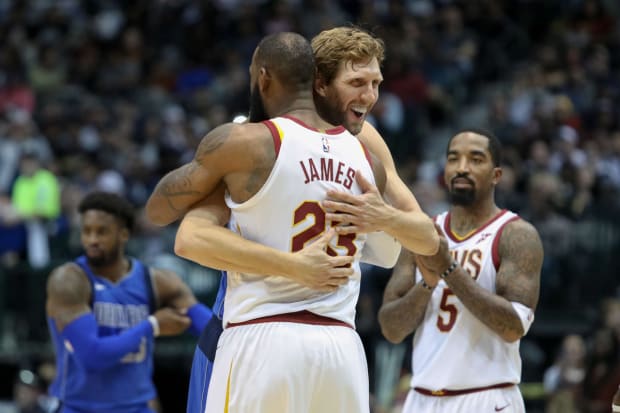
Andrew Dieb/USA TODAY Sports
A decade ago, it was the Mavericks who were desperately trying to extend an era for the sake of their aging star. They saved their cap room, chased every star free agent—from Dwight Howard and Deron Williams to Carmelo Anthony and LaMarcus Aldridge—and took fliers on Monta Ellis, Chandler Parsons, O.J. Mayo and Rajon Rondo.
“When you go all in like that, there’s a risk,” Mavericks owner Mark Cuban says of the Lakers. “In their case, they won a championship. If I won the championship, and I went all in, and I knew we were kind of mortgaging our future … I’ll take it all day long. But it’s always painful when you get past it.”
The Mavericks never did find a suitable costar before Nowitzki started his decline, making the challenge even greater. His last real moment of glory came in 2014, at age 35, when the eighth-seeded Mavericks took the (eventual champion) Spurs to seven games in the first round. “We pushed them to the brink,” Nowitzki says. “One or two different bounces in one of the other games, we could have probably come through.”
By then, Nowitzki’s prowess was waning. They never did win another series. But Nowitzki looks at James and sees a star who’s still capable of anchoring a contender.
“I’m in awe of what he does in Year 20,” Nowitzki says. “I mean, in Year 20, the team was kind of carrying me up and down in a wheelbarrow or something.”
Looking back, Nowitzki says he endured it all because he trusted Cuban and general manager Donnie Nelson and because, regardless of circumstance, he felt a loyalty to the franchise and the city where he’d spent his entire career.
“It comes with sticking with the program, and not leaving when times are tough,” Nowitzki says. “[James] decided to stay there and make it work, and it’s part of the gig. You got to fight through some tough times and find ways to use your experience to turn the situation around.”
Of course, James has no such roots in Los Angeles, or with the Lakers, or with the franchise’s top leaders. On the contrary, James is the very avatar of the player empowerment era, a mercenary willing to sever alliances and inflame fans in pursuit of basketball immortality.
Can James sustain his dominance at age 38? Can the Lakers parlay those efforts into a playoff run without a major trade? That all remains to be seen. But if the Lakers do squander one of LeBron’s last great seasons, if Year 20 becomes another humiliation, it’s hard to imagine he’ll stick around for Year 21.







